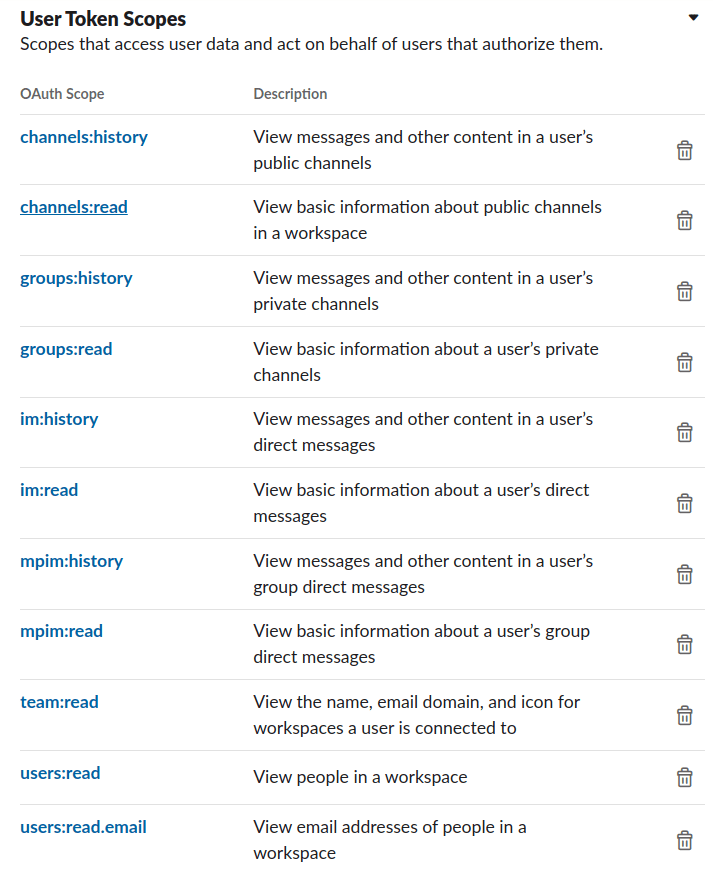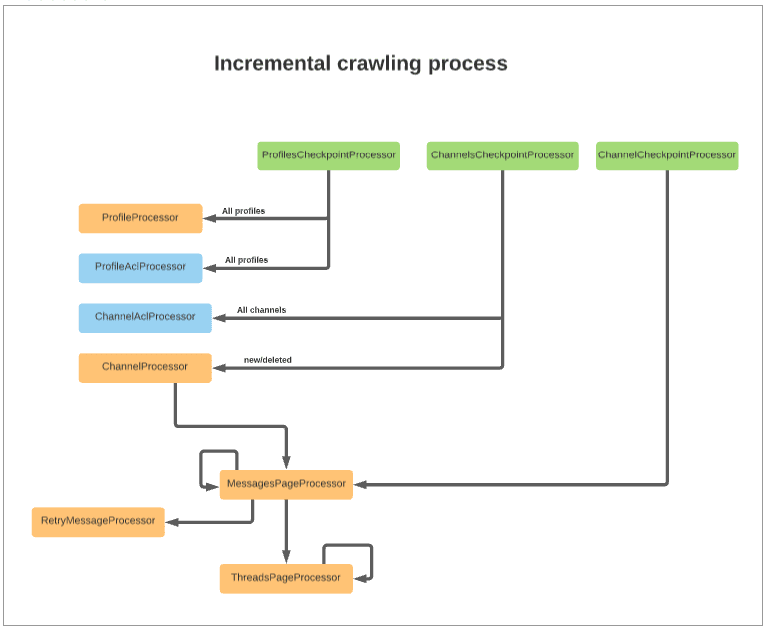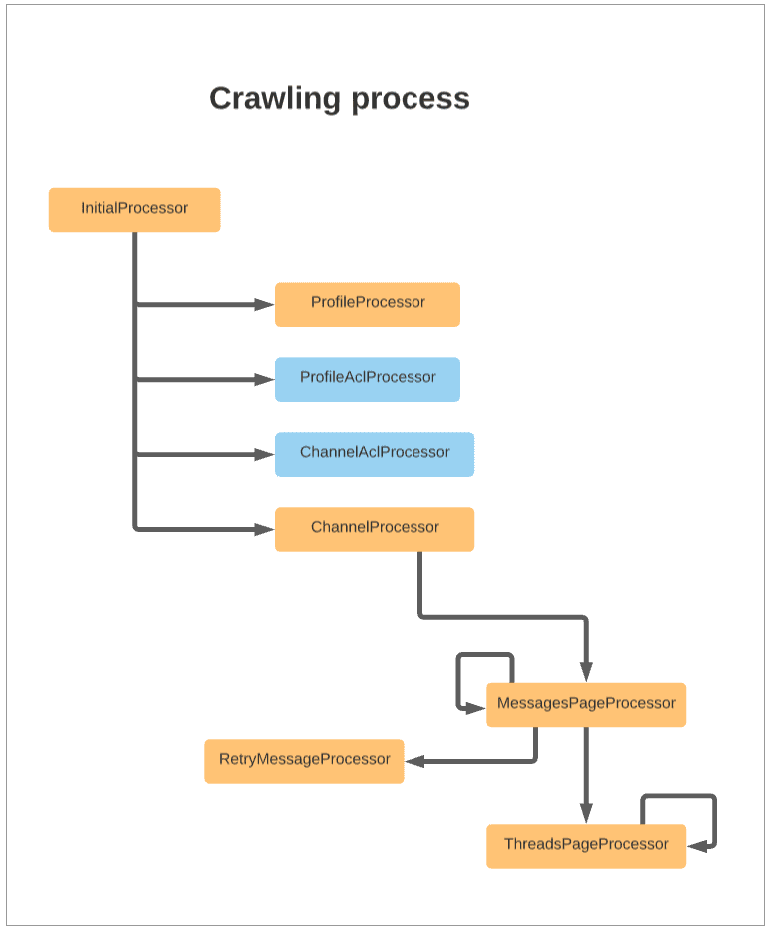Slack V2 Connector Configuration Reference
The Slack V2 connector allows you to index Slack channels and messages.
|
Due to rate limit restrictions in the Slack Web API, this connector has the following restrictions:
|
Authentication
You must install a Slack application in the workspace that will be indexed before using the Slack V2 connector. See Slack’s Basic app setup for more information about installing a Slack application.
Once the app is correctly installed in the workspace, Slack will provide an access token, which you will then use in the Slack V2 connecter configuration.
Required application scopes
The Slack application must provide access to the following User Token Scopes in order to work with Slack V2 connector:

Initial actions
The Slack V2 connector will perform the following actions at the beginning of each job:
-
Load all users in the users cache. This information will be used later to resolve user names when processing mentions in messages.
It will also be useful for avoiding requests to retrieve user’s metadata.
-
Load the channels to be processed using the channel filtering properties from the configuration.
This will be useful to establish a source of truth when determining whether a channel should be indexed or deleted on each job.
Document filtering
| Profiles indexing | |
|---|---|
|
Determines whether users are indexed |
|
Determines whether profiles from guest users are indexed |
|
Determines whether profiles of deactivated users are indexed |
Channels indexing |
|
|
Determines whether a document per channel is indexed |
|
Determines whether archived channels are indexed to the content collection |
|
Determines whether public channels are indexed |
|
Determines whether private channels are indexed |
|
Determines whether direct and multi-party direct message only are indexed |
|
A list of the channel names to be included in the crawling process |
Messages indexing |
|
|
Determines whether messages from the channels are indexed |
|
Determines where messages from bots in channels are indexed |
|
Determines whether the replies (if applicable) to messages are indexed |
Crawling process
| Due to limitations in the Slack Web API, edited and deleted messages cannot be retrieved. You must clear the datasource and start a new connectors job to index edited messages and/or remove deleted messages. |
Endpoints used in the crawling process
| Endpoints | Description |
|---|---|
Lists all users in the workspace. This is not controlled by the properties in Document Filtering. All users are retrieved at the beginning of each job. |
|
Lists the channels that should be indexed. This fetching is guided by the properties listed in Document Filtering. |
|
Lists the members of specific channels being indexed. |
|
Retrieves a page of messages from a specific channel |
|
Retrieves the information of a single user, if it’s not present in the users cache (message document generation). |
|
Retrieves the information of a single channel, if it’s not present in the channel’s cache (message document generation). |
|
Retrieves the information of a team (message document generation). |
|
Retrieves a page of replies from a specific message from a channel. |
Message mentions processing
The Slack V2 connector retrieves messages from the Slack API in the following format:
"type": "message", "text": "this is a mention in a message: <@U01U580HSDN>",
In this example, @U01U580HSDN is the user Id. The connector will resolve the user Id with the user’s display name, if it exists. Otherwise, it will use the full name in the user’s profile.
Incremental Crawling processors

Each incremental job will re-index the User ACL to update all users in the Access Control Collection, and the Channel ACL to update the members of each channel.
| Processor | Description |
|---|---|
|
Performs the following actions:
|
|
Detects new and deleted channels by comparison and the triggers the re-indexing of the channel ACL documents. |
|
Verifies that the current channel should still be indexed. If the channel should still be indexed, then it triggers the indexing of new messages providing the timestamp ( |
Security filtering
Security filtering processors
| Processor | Description |
|---|---|
|
Builds a document representing a Slack user, which is then sent to the Access Control Collection. Regular users can access public channels, even if they are not members of the channel. Guest users can access only the channels they are members of. |
|
Retrieves the current members of the given channel, builds a document with those values, and sends the document to the Access Control Collection. In public channels, an extra document is sent to the Access Control Collection to provide access to regular users who are not members of public groups. |
Security trimming rules
Security trimming uses the following rules:
-
All users (regular and guest) can see the profile of any user in the Slack workspace.
-
All regular users can access public channels and messages, even if they are not members of the channel.
-
Guest users can only access the public or private channels they are members of.
-
Only the members of private channels can access the channel and messages.
-
Only the users involved can access direct messages and multi-party direct messages.
Remote connectors
V2 connectors support running remotely in Fusion versions 5.7.1 and later. Refer to Configure Remote V2 Connectors.

